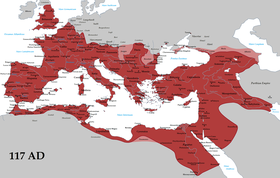
Back حرب كيتوس Arabic حرب كيتوس ARZ Китоска война Bulgarian Guerra de Kitus Catalan Diasporaaufstand German Δεύτερος Ιουδαϊκός Πόλεμος Greek Dua Juda-Romia Milito Esperanto Guerra de Kitos Spanish Kitosen Gerra Basque جنگ کیتوس Persian
You can help expand this article with text translated from the corresponding article in Hebrew. Click [show] for important translation instructions.
|
| Kitos War or Second Jewish–Roman War | |||||||||
|---|---|---|---|---|---|---|---|---|---|
| Part of the Jewish–Roman wars | |||||||||
 The extent of the Roman Empire under Trajan (117) | |||||||||
| |||||||||
| Belligerents | |||||||||
| Roman Empire | Jewish/Judean zealots | ||||||||
| Commanders and leaders | |||||||||
| |||||||||
| Casualties and losses | |||||||||
|
Cassius Dio: 460,000+ Roman subjects (largely Roman Greeks) were killed in Cyrene and Cyprus alone Unknown numbers in Aegyptus, Libya and the rest of the Eastern Mediterranean |
200,000 dead[2] Jewish communities of Cyprus, Cyrene and possibly others completely depopulated and permanently expelled to the eastern edges of the Empire (mainly Judea) | ||||||||
The Kitos War (115–117; Hebrew: מרד הגלויות, romanized: mered ha-galuyot, or מרד התפוצות mered ha-tfutzot; "rebellion of the diaspora" Latin: Tumultus Iudaicus) was one of the major Jewish–Roman wars (66–136). The rebellions erupted in 115 when most of the Roman armies were fighting Trajan's Parthian War on the eastern border of the Roman Empire. Major uprisings by Jews in Cyrenaica, Cyprus and Egypt spiralled out of control, resulting in a widespread slaughter of the remaining Roman garrisons and Roman citizens by Jewish rebels.
The Jewish rebellions were finally crushed by the Roman legions, chiefly by the Roman general Lusius Quietus, whose nomen later gave the conflict its title, as Kitos is a later corruption of Quietus. Some localities were so utterly annihilated that Romans moved in to settle the areas to prevent their complete depopulation. The Jewish leader, Lukuas, fled to Judea.[3] Marcius Turbo pursued him and sentenced to death the brothers Julian and Pappus, who had been key leaders in the rebellion.[4]
Lusius Quietus, the conqueror of the Jews of Mesopotamia, was now in command of the Roman army in Judea and laid siege to Lydda, where the rebel Jews had gathered under the leadership of Julian and Pappus. Lydda was next taken, and many of the rebellious Jews were executed. The "slain of Lydda" are often mentioned in words of reverential praise in the Talmud.[5] The rebel leaders Pappus and Julian were among those who the Romans executed that year.[6]
The situation in Judea remained tense for the Romans, who were obliged under Hadrian to move the Legio VI Ferrata permanently into Caesarea Maritima in Judea.
- ^ a b Malamat, Abraham (1976). A History of the Jewish people. Cambridge, Mass: Harvard University Press. p. 330. ISBN 978-0-674-39731-6.
- ^ Beck (2012). True Jew: Challenging the Stereotype. p. 18.
- ^ Abulfaraj, in Münter, "Der Jüdische Krieg," p. 18, Altona and Leipsic, 1821
- ^ Kitos War: A Captivating Guide to One of the Jewish–Roman Wars (History of Judaism). Captivating History. ISBN 978-1637166369.
- ^ Pes. 50a; B. B. 10b; Eccl. R. ix. 10
- ^ Ta'anit 18b; Yer. Ta'anit 66b
© MMXXIII Rich X Search. We shall prevail. All rights reserved. Rich X Search